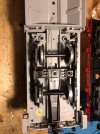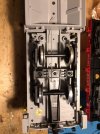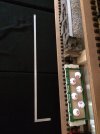I run LGB Toy Train wagons because they are shorter than other types and so better for my size of layouts. However, some have an annoying habit of the bogie failing to straighten up after rounding curve. This doesn't seem to cause any problem in running (although it must increase drag an wear on the wheels), bit it does look untidy.
I have thought of two possible solutions, polishing up the underside of the wagon body which touches the bogie or inserting a washer between the body and the bogie.
I've not had time to try either of these yet, but wondered if anyone had had the same problem, either with Toy Train or other rolling stock, and had come up with a solution.
I have thought of two possible solutions, polishing up the underside of the wagon body which touches the bogie or inserting a washer between the body and the bogie.
I've not had time to try either of these yet, but wondered if anyone had had the same problem, either with Toy Train or other rolling stock, and had come up with a solution.







